Aphids can weaken our plants so much that they die. We reveal which beneficial insects help against lice in the garden and how to use parasitic wasps, lacewings and the like against aphids.

aphids (Aphidoidea) are a frequent but mostly uninvited guest in our gardens, greenhouses or on the windowsill. The plant sap suckers are only a few millimeters in size and colored green to black depending on the species. As they feed on the plant's phloem sap, they excrete what is known as honeydew, which can be seen as a sticky, shiny coating on leaves. Another feature of the aphid is leaf curling and reduced growth of the plant as a result of sucking activity. We introduce you to the most important beneficial insects against aphids in order to take ecological action against aphids.
Which beneficial insects help against aphids?
the parasitic wasp and the ladybug are certainly the best-known representatives of beneficial insects that can be used against aphids. But also
lacewings and gall midges are there to help you if your plants are infested with aphids. Here, just for plants in greenhouses, conservatories and for Indoor plants with aphids Beneficial creatures can be acquired and settled in a targeted manner. In the field, it is advisable to create habitats in which beneficial insects feel comfortable, so that they migrate on their own. Settling outdoors is not that easy, as the beneficial insects often simply spread around and do not remain on the treated plant.Ichneumon wasps against aphids
Some parasitic wasps (Ichneumonidae) are parasitized by aphids, which offers a very good opportunity for natural control. The female lays eggs in aphid larvae or adult aphids and in this way suppresses its host, i.e. the plant pest.
Ichneumon wasps can be used against aphids both outdoors and indoors. A female parasitic wasp can parasitize around 500 aphids in a short time. The female uses her ovipositor to lay an egg in the aphid that has been stunned by the parasitic wasp. The larva that later hatches from the egg then kills the louse. The few millimeters large parasitic wasp is completely harmless to plants and humans. You can buy these beneficial insects against aphids on the Internet or in specialist shops in small containers. These containers are hung on the plant infested with aphids and the little helpers spread themselves. The use of parasitic wasps is possible from a temperature of over 15 °C. Before use, the aphid species should be determined or a mixture of different parasitic wasp species should be used. A certain species of parasitic wasp can only parasitize a few species of aphids. Suppliers of parasitic wasps will be happy to advise you on this. Ichneumon wasps can also control whiteflies, codling moth and cabbage whites help. Anyone who does not want to do without the help of parasitic wasps outdoors has the option of offering a living space in the form of small wooden trunks with holes a few millimeters in size.
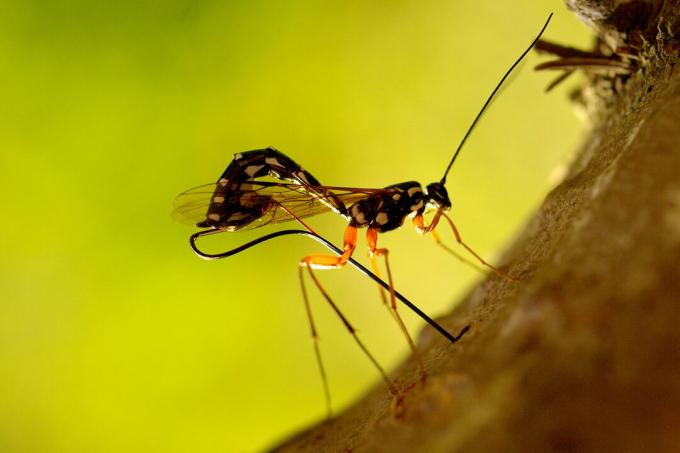
Here you will find the most important aphid species and the matching parasitic wasps:
| Aphid species: | Ichneumon wasp species: |
|---|---|
| peach aphid (Myzus persicae) | Aphidius Colemani |
| Green cucumber aphid (Aphis gossypii) | Aphidius Colemani |
| potato aphid (Macrosiphum euphorbiae) | Aphidius matricariae |
| Black bean aphid (Aphis fabae) | Lysiphlebus testaceipes |
Ladybugs against aphids
The Seven Spot Ladybug (Coccinella septempunctata) is known to many as a lucky charm - and it also helps us against aphids. The ladybug only feels comfortable outdoors. The adult animal also likes to eat aphids, but the blue-black ladybird larvae, which are three to nine millimeters in size, are much more voracious. A single larva can eat up to 4,000 aphids in two weeks. So that is Use of ladybird larvae against aphids also suitable for a heavy infestation. You can order ladybug eggs in small containers online, which you then spread on the infested plant in the evening or when the sky is cloudy. The voracious larvae soon hatch from the eggs at a temperature of 15 to 20 °C. If you want to settle the beneficial insects against aphids in your garden, you can promote this with natural hedges and native plants such as the white goosefoot.
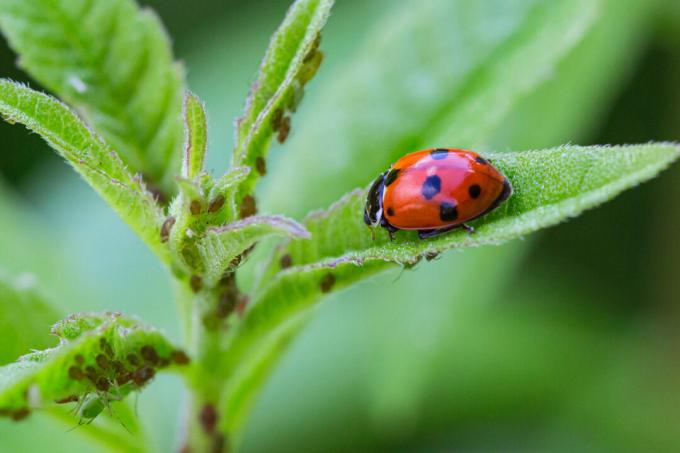
Lacewings against aphids
the Lacewing larvae (Chrysoperla carnea) are also known as "aphid lions" because of their hairy appearance and also like to eat aphids. Lacewings can be used against aphids outdoors and in greenhouses. They grab the aphids with their suction pincers and suck them out. A lacewing larva can eat up to 800 aphids in two weeks. The beneficial insects against aphids can be used both outdoors and in greenhouses or in the living room. Lacewings can be used at temperatures above 10°C. You can buy the larvae embedded in corrugated cardboard on the Internet and spread them over the affected plant by tapping them lightly. The lacewing is the ideal beneficial if your plant is not only affected by aphids, but also by thrips or spider mites is infested, since the lacewing larvae are only too happy to eat them.
The lacewing feels particularly at home in your garden if you offer natural hedges and leave the autumn leaves over winter. Lacewings can be specifically attracted with a red-painted lacewing box, in which they can also find shelter.
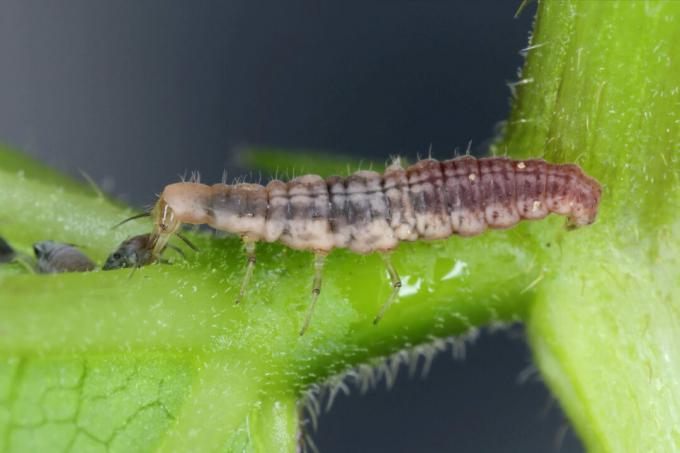
gall midges
gall midges (Aphidoles aphidimyza) are only suitable for use against aphids in greenhouses or living spaces. The gall midge larva stuns the pests and sucks them out. A larva can suck out up to 80 aphids within a week. The earlier the beneficial insects are used against aphids, the more effectively they are reduced. It can be used at temperatures above 18 °C between March and September. Occasional spraying of the plant with water also helps with the settlement of the gall midge larvae. The larvae and adults are completely harmless to plants and humans. Gall midge pupae can be ordered online, from which the orange larvae hatch. The pupae are placed on the soil under the infested plant.
Predatory mites against aphids
predatory mites are excellent for combating an infestation by spider mites or thrips, for example. However, if your plants are infested with aphids, the use of predatory mites will not be successful. Aphids are not on the menu of predatory mites, which is why we recommend using the beneficial insects presented so far.
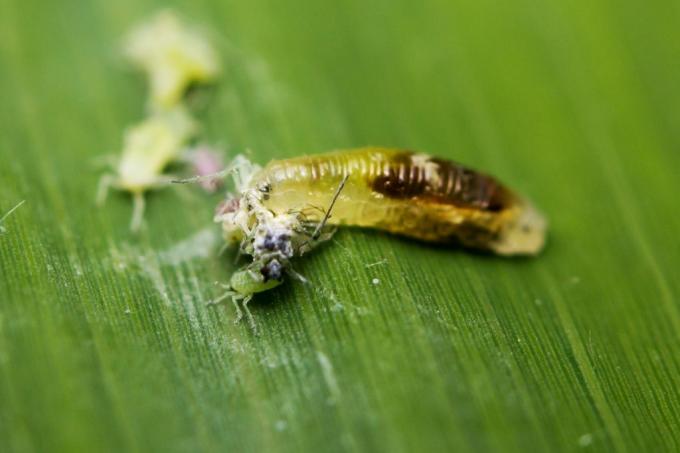
How to fight aphids with beneficial insects
You can specifically buy and settle some beneficial insects in the event of an acute infestation. But if you want to prevent pests such as aphids from multiplying too much, you should welcome and keep beneficial insects in the garden. You can do this with a flower meadow that not only looks very beautiful, but also provides food for insects. Our Plantura beneficial insect magnet is a seed mix with over 20 different plants that will help you create such a meadow in no time at all.
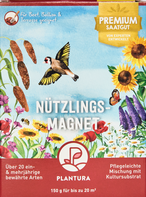
Plantura beneficial insect magnet
Annual & perennial species for beneficial insects
such as birds, bees & Co, easier to care for
Blossom dream in bed, pot & window box
Our gardens can get very dry, especially in summer, which can pose a problem for the insects that live there. Insect drinkers can help with this. A small bowl of water and small pieces of cork or wood floating on the surface of the water give the insects a chance to drink.
The use of only insect-friendly plant protection measures is also important. Small retreats like piles of wood and bark or abandoned faded perennial stems also help encourage beneficial insects in your garden. An insect hotel is also a good idea - it gives the beneficial insects shelter and the opportunity to reproduce. This way you not only keep pests at bay, but also encourage insects that help pollinate your plants.
By the way: Aphids are not just like insects parasitic wasps, ladybugs, lacewings and gall midges gladly eaten, but also by birds. These can also be promoted as beneficial insects in the garden. Nesting boxes in trees, hedges or a quiet corner in your yard give birds like that blue tit the opportunity to nest. The parents will help you keep the pests under control.
Sometimes animal helpers can no longer contain the aphid plague. In such cases, our Plantura helps Organic Pest Free Neem. The 100% herbal remedy from the seeds of the neem tree helps reliably and naturally against pests such as aphids and the like.
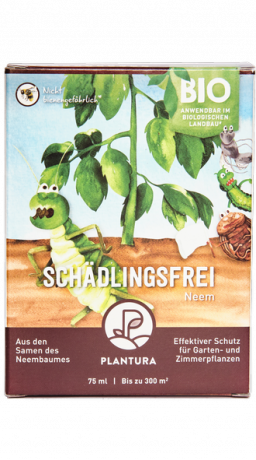
Plantura Organic Pest Free Neem
Highly effective & natural spray
against aphids, potato beetles & Co,
from the seeds of the neem tree
...and receive concentrated plant knowledge and inspiration directly in your e-mail inbox every Sunday!



